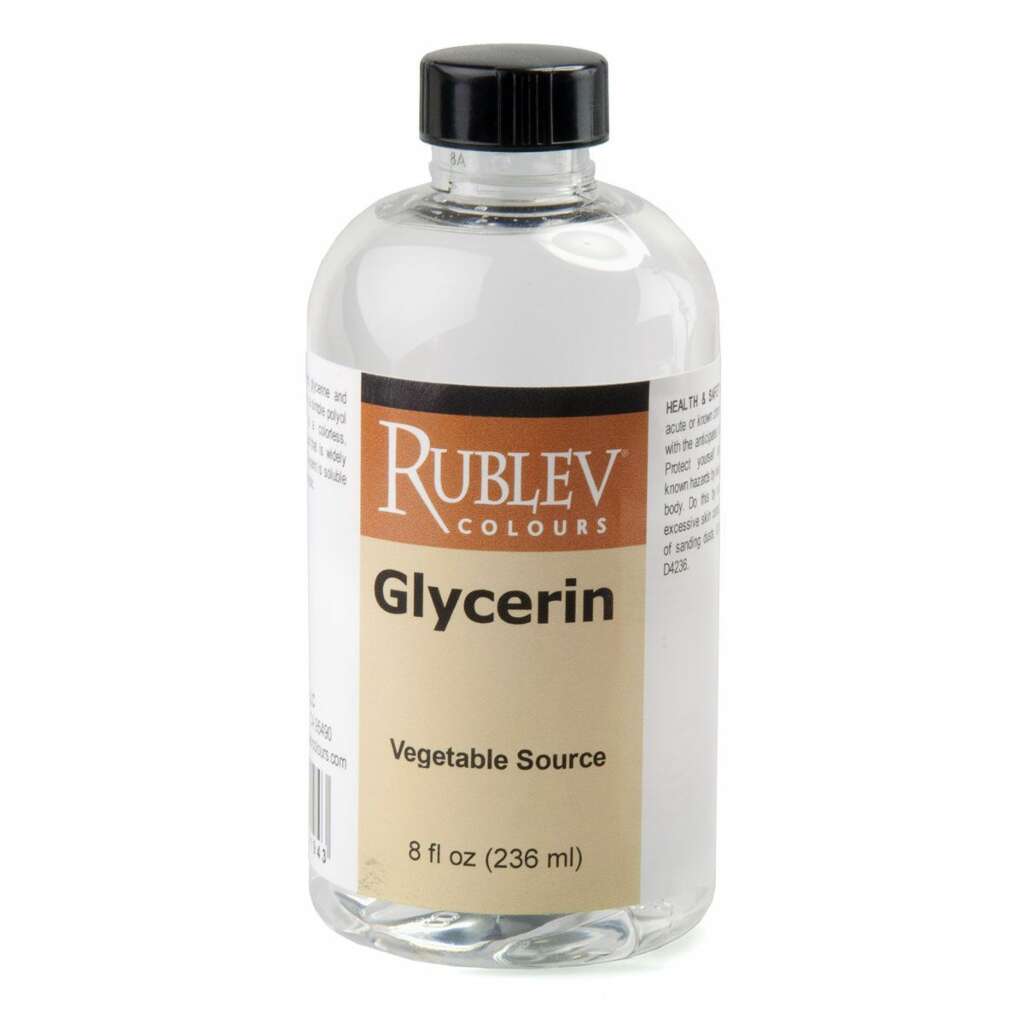Glycerin 8 fl oz
$10.60
In stock
SKU
500-GCRN08
Add to glues and starches to make them more flexible amd prevent cracking. Makes watercolor wetter and last longer on the palette.
Glycerin is chiefly used as a moistening and plasticizing agent, particularly for aqueous mediums such as egg white, gelatin and gum. Add it to glues and starches to make them more flexible and prevent cracking. Makes watercolor wetter and last longer on the palette.
Glycerin is a colorless, transparent, and odorless sweet syrupy liquid. Glycerin is a hygroscopic trihydroxy alcohol (HOCH2CHOHCH2OH) that occurs combined as glycerides and is formed by alcoholic fermentation of sugars, that is usually obtained as a by-product in the manufacture of soap or fatty acids by the saponification of fats or as a synthetic product from propylene or allyl alcohol, and that is used chiefly as a solvent and plasticizer, as a moistening agent, emollient, and lubricant, as an emulsifying agent, and as a starting material in the manufacture of many derivatives.
Origin and History
The word is derived from the Greek word glykys meaning sweet. In 1779, Swedish scientist K. W. Scheele discovered glycerin in a hydrolysate of olive oil. Initially, glycerin was used in the manufacture of glue and cork, and over time applications extended to use in dye auxiliaries for textiles and ink. In 1867, A. B. Nobel manufactured dynamite from glycerin, a development that proved a major turning point in the expansion of applications for glycerin.
Source
Glycerin is prevalent in higher plants, seaweed, and in animals. In humans, glycerin is accumulated subcutaneously or in muscle tissue in the form of lipids. Substances for which fatty acids are ester-bonded to all three hydroxyl groups in the glycerin structure are known as lipids or oils and fats. There are two types of glycerin: natural glycerin derived from oils and fats from such, sources as coconuts and oil palms, and synthetic glycerin derived from petroleum. In the manufacture of natural glycerin, normally crude glycerin is produced by first refining and condensing an aqueous solution (sweet water) obtained from hydrolysis of oils and fats, then further distilling and refining the solution until arriving at the finished product. At present, because of the need to reuse resources, natural glycerin is the predominate type manufactured worldwide.
Our glycerin is derived from a natural source, oil palms in Malaysia, and is 99.74% pure.
This product fully complies with the monograph requirements for USP and FCC glycerin.
Glycerin absorbs moisture, so keep tightly closed in a cool, dry place away from direct light.
Glycerin is a colorless, transparent, and odorless sweet syrupy liquid. Glycerin is a hygroscopic trihydroxy alcohol (HOCH2CHOHCH2OH) that occurs combined as glycerides and is formed by alcoholic fermentation of sugars, that is usually obtained as a by-product in the manufacture of soap or fatty acids by the saponification of fats or as a synthetic product from propylene or allyl alcohol, and that is used chiefly as a solvent and plasticizer, as a moistening agent, emollient, and lubricant, as an emulsifying agent, and as a starting material in the manufacture of many derivatives.
Origin and History
The word is derived from the Greek word glykys meaning sweet. In 1779, Swedish scientist K. W. Scheele discovered glycerin in a hydrolysate of olive oil. Initially, glycerin was used in the manufacture of glue and cork, and over time applications extended to use in dye auxiliaries for textiles and ink. In 1867, A. B. Nobel manufactured dynamite from glycerin, a development that proved a major turning point in the expansion of applications for glycerin.
Source
Glycerin is prevalent in higher plants, seaweed, and in animals. In humans, glycerin is accumulated subcutaneously or in muscle tissue in the form of lipids. Substances for which fatty acids are ester-bonded to all three hydroxyl groups in the glycerin structure are known as lipids or oils and fats. There are two types of glycerin: natural glycerin derived from oils and fats from such, sources as coconuts and oil palms, and synthetic glycerin derived from petroleum. In the manufacture of natural glycerin, normally crude glycerin is produced by first refining and condensing an aqueous solution (sweet water) obtained from hydrolysis of oils and fats, then further distilling and refining the solution until arriving at the finished product. At present, because of the need to reuse resources, natural glycerin is the predominate type manufactured worldwide.
Our glycerin is derived from a natural source, oil palms in Malaysia, and is 99.74% pure.
This product fully complies with the monograph requirements for USP and FCC glycerin.
Glycerin absorbs moisture, so keep tightly closed in a cool, dry place away from direct light.
| SKU | 500-GCRN08 |
|---|---|
| Brand | Rublev Colours |
| Vendor | Natural Pigments |
| Processing Time | Usually ships the next business day. |
| Size | 8 fl oz (236.5 ml) |



